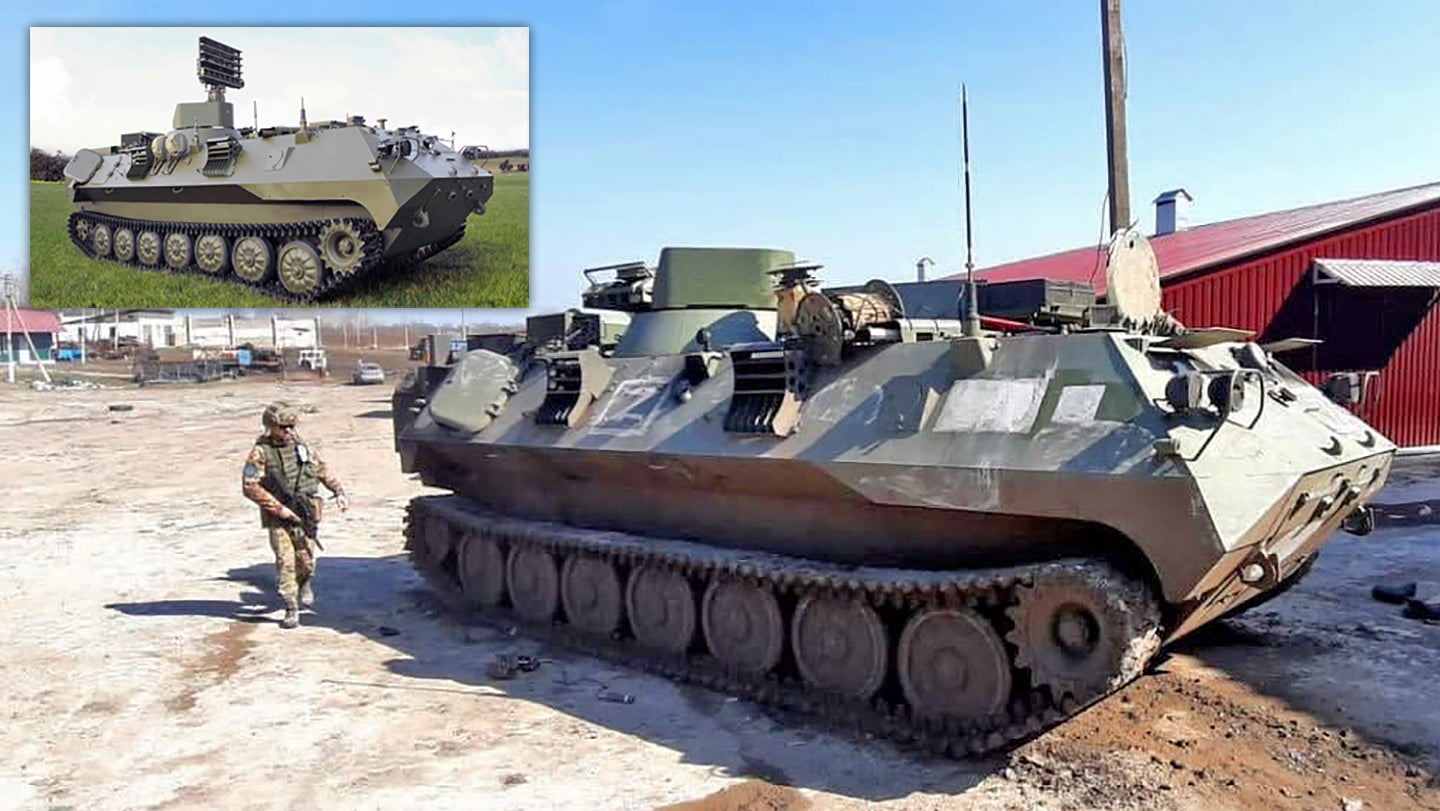As the war in Ukraine unfolds, Russia continues to bleed with each passing day in terms of its sophisticated military technology with Ukrainian forces confiscating various advanced Russian weapon systems.
Images have emerged from Ukraine showing a radar-equipped air defense command post vehicle which is a component of a larger system known as Barnaul-T, captured by Ukrainian forces in the northeastern Kharkiv region.

On March 27 images surfaced on social media of this vehicle known as 9S932-1 or MRU-B relatively intact, with other Russian vehicles and artillery pieces in the town of Husarivka. This is the third instance of this component being captured by Ukrainian troops.
The first 9S932-1 was captured near capital Kyiv sometime around March 3 and the Ukrainian forces have reportedly accommodated it for their service in an unclear capacity. While the second one, also in fairly good condition, was found in the Kharkiv region on or about March 12.
Barnaul-T is Russia’s most modern and highly automated baseline air defense command and control subsystem within the integrated troop and weapon management system designed for air defense systems of the Army, Marine units, and Airborne forces.
#Ukraine: The Ukrainian forces successfully took over Husarivka, #Kharkiv Oblast. As a result a Russian T-72B tank, Barnaul-T automated system for air defense units, Msta-B 152mm howitzer, TZM-T reloading vehicle for the TOS-1A were captured. pic.twitter.com/r2PpVxaND8
— ?? Ukraine Weapons Tracker (@UAWeapons) March 27, 2022
It is designed to fit the air defense control posts of tactical units and consists of advanced automation, communication, and data exchange equipment that enables effective control of air defense troops and weapons, coordination of their activities, and increases their mobility and survivability under any combat conditions.
Reports suggest that it enhances the ability of the air defense forces to quickly detect and engage various threats across the whole section of the battlespace by up to 20% in terms of efficiency and reduces the expenditure of missiles per killed target by up to 30%.
Barnaul-T entered service with the Russian Armed Forces in 2009 and first appeared in the Donbas region of Ukraine in 2015.
The 9S932-1 is the reconnaissance/control module of the Barnaul-T subsystem supported by 1L122-1E radar and is mounted on a BTR-MD Rakushka amphibious tracked chassis or MT-LBU. It conducts round-the-clock reconnaissance and exercises command and control of subordinate troops and their armaments in warfare on combat positions.
Video of a Russian military column in Kherson with a what looks like a Zhitel electronic warfare system, 3 Tor-M2/M2U air defense TLAR, and possibly a Barnaul-T 9S932-1 command post. https://t.co/kVJAa1j7K1 pic.twitter.com/Hpyb0GqPOJ
— Rob Lee (@RALee85) February 28, 2022
The module is directly linked to units equipped with various Short Range Air Defense Systems (SHORAD) systems, such as tracked Tor-M-series (SA-15) and 9K35 Strela (SA-13) surface-to-air missile systems, 9K33 Osa (SA-8) wheeled surface-to-air missile systems, 2K22 Tunguska (SA-19) tracked air defense systems, and 9K333 Verba (SA-25) shoulder-fired surface-to-air missiles, also known as a man-portable air-defense systems (MANPADS).

The Russian Ministry of Defense released a video around March 28 which shows how Russian forces shot down a Ukrainian UAV using Strela (SA-13) SHORAD systems with Barnaul-T command posts.
Russian MoD video showing Strela-10MN SHORAD systems with Barnaul-T command posts shooting down a Ukrainian UAV. https://t.co/eddR7Y1ZFu pic.twitter.com/fnNPW40FYO
— Rob Lee (@RALee85) March 28, 2022
While additional equipment may be required to link the 9S932-1s to some of the SHORAD systems such as the 9K333 Verba which uses a supplementary system called the 9S935 to connect it to the broader Barnaul-T network via a standalone 9S933 fire control module at the platoon level.
The 1L122-1E seen in the videos is a smaller variant of the 1L122 series air defense radars that can detect, position, and track aircraft, cruise missiles, and unmanned aerial vehicles and conduct friend-or-foe identification and automatically transmit tracking data to the automated control system.
The radar is small and portable and can be rapidly delivered to an assigned point, even in a hard-to-reach location. The set can be broken down into multiple units, each weighing less than 30 kg which makes it possible to deliver it by airdrop or any other means of transportation.
The 1L122-1E can detect targets up to a range of 40 km and at an altitude of 10 km, while some reports suggest that the range and altitude have both been improved up to 80 km and 20 km, respectively. The data update rate for the 1L122-1E is between 2-4 seconds.
The capture of a component belonging to such a sophisticated weapon system as Barnaul-T represents a great achievement for the Ukrainian resistance as this stands to limit the ability of the Russian forces to provide air defense cover for their units and ensure that the Ukrainian airspace remains contested.
Furthermore, this can be a goldmine for the Western Intelligence agencies as 9S932-1 or 1L122 radar can provide them with invaluable information on Russian air defense systems, radars, data links, etc. These agencies can acquire detailed data on 1L122’s specific signature that can help them develop effective capabilities for suppression of enemy air defenses (SEAD) operations.
While the various communications and data sharing systems can shed light on how data is encoded and transferred from the Russian software applications that run these systems. The coded identification friend or foe (IFF) data onboard the captured vehicles can be exploited for electronic and cyber warfare purposes.
This could have disastrous long-term consequences for Russia as it stands to undermine the efficacy of the Russian weapon systems. Ukraine has long been a valuable source for the U.S. when it comes to such types of Russian military equipment.
For example, in September 2018, the U.S. Army reportedly acquired the Ukrainian 36D6M1-1 radar associated with the S-300 surface-to-air missile system which is not only fielded in Russia and Ukraine but also in numerous other countries around the world, such as Iran and Syria.
- Written by Tanmay Kadam/EurAsian Times Desk
- Contact the author at etdesk@eurasiantimes.com
- Follow EurAsian Times on Google News




